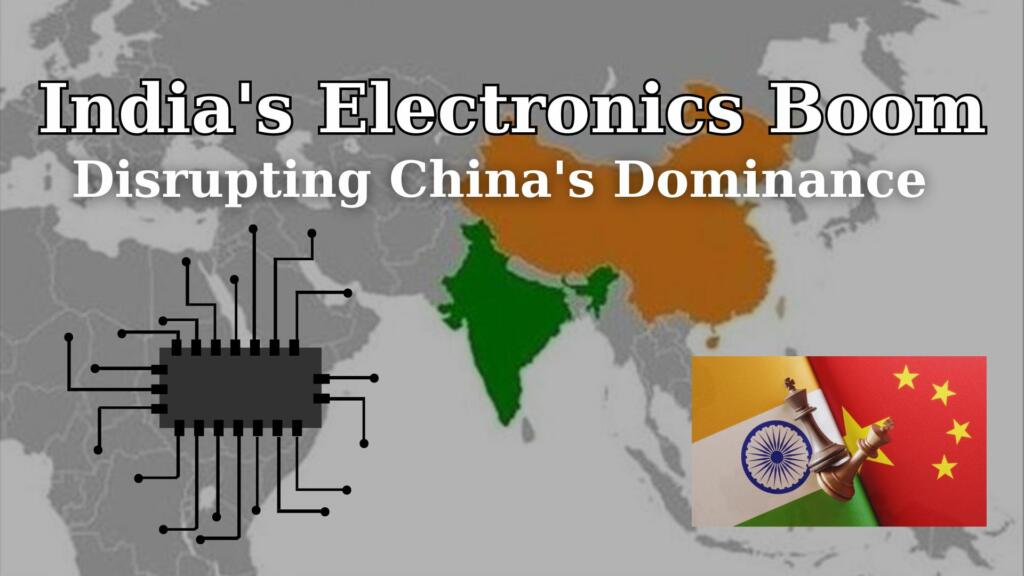India’s electronics exports are on the rise, reshaping global supply chains amid escalating geopolitical tensions with China. As manufacturers seek alternative production hubs, India’s strategic incentives, including tax cuts and easier land acquisition, coupled with burgeoning partnerships with major companies like Samsung and Apple, are positioning it as a formidable player in the electronics market. This shift underscores India’s growing significance in the global economy and highlights the potential for further expansion in the electronics sector.
Diversification of Supply Chains
The shift away from China’s dominance in electronics manufacturing towards other Asian countries marks a strategic diversification of global supply chains. India has emerged as a prime destination, enticing electronics manufacturers with a range of incentives such as tax cuts, rebates, and streamlined land acquisition processes. Case studies of industry giants like Samsung and Apple showcase the significant investments made in establishing manufacturing bases in India, underlining the country’s growing importance as a key player in the global electronics market. This trend reflects a broader reconfiguration of supply chains aimed at mitigating risks and capitalizing on emerging opportunities in diverse markets.
Impact on Key Markets
India’s expanding electronics exports are notably impacting key markets such as the US and UK. Examination reveals a growing market share in both countries, underpinned by compelling statistics showcasing the rise in India’s electronic00000s exports relative to China’s. This shift is influenced by the geopolitical context, where tensions between the US, UK, and China have heightened, prompting a reevaluation of trade dynamics. As geopolitical considerations increasingly shape trade decisions, India’s position as a reliable alternative supplier gains traction, signaling a significant reorientation in global electronics trade patterns.
Also Read: The Great Firewall Breached: China’s Cyber Shenanigans Unmasked
Dual Supply Chain Strategy
India’s progress in Europe and Japan in comparison to the US and UK reflects the implementation of a ‘China plus one’ strategy by multinational corporations. While India’s market share in the US and UK electronics markets has shown significant growth, its penetration into European and Japanese markets has been comparatively limited. The ‘China plus one’ strategy involves diversifying supply chains by establishing backup production capacity in countries like India alongside China, mitigating risks associated with overreliance on a single manufacturing hub.
India’s role in this strategy lies in providing backup capacity for multinational corporations, offering a reliable alternative to Chinese production. As tensions between China and major trading partners escalate, India’s appeal as a manufacturing destination strengthens. However, challenges such as infrastructure development and regulatory reforms need to be addressed to fully capitalize on this opportunity. Overall, India’s emergence as a key player in global supply chains underscores its strategic importance in the evolving landscape of international trade.
Economic Implications and Political Landscape
India’s ‘Make in India’ initiative has significant economic implications, particularly in terms of job creation and fostering economic self-reliance. By promoting domestic manufacturing and incentivizing investments, the initiative aims to reduce dependency on imports and stimulate job growth in key sectors like electronics. The initiative has shown promising results, with the establishment of manufacturing hubs and increased production capacities contributing to employment opportunities across various skill levels.
Prime Minister Narendra Modi’s political agenda aligns closely with the ‘Make in India’ initiative, reflecting a broader strategy to bolster India’s economy and assert its global standing. Modi’s emphasis on economic reforms and infrastructure development complements the initiative’s goals, fostering an environment conducive to business growth and investment.
India’s trade relations with the US and China have witnessed notable shifts in bilateral trade patterns. While the US has emerged as India’s largest trading partner, surpassing China, trade dynamics with both countries have evolved in response to geopolitical tensions and changing economic priorities. India’s trade with the US has seen steady growth, driven by factors like restoration of GSP benefits and strengthening economic ties. Conversely, trade with China has experienced fluctuations, reflecting shifts in demand and trade policies. Overall, India’s evolving trade relations underscore the country’s strategic adaptability and growing importance in the global economy.
Future Outlook
The future outlook for India’s electronics exports is promising, with continued growth anticipated to have significant implications for global trade. India’s strategic incentives and partnerships with major electronics manufacturers position it as a key player in the industry. As geopolitical tensions persist and supply chain diversification becomes a priority for multinational corporations, India is poised to capitalize on this trend and further expand its market share in the electronics sector.
In conclusion, India’s electronics exports surge amid geopolitical tensions with China underscores its rising prominence in global supply chains. Strategic incentives, coupled with partnerships with tech giants, position India as a formidable player in the electronics market, driving diversification away from China. Impacting key markets like the US and UK, India’s ‘Make in India’ initiative fosters economic self-reliance while Modi’s political agenda aligns with bolstering the economy. As a ‘China plus one’ destination, India’s role in dual supply chain strategies is vital. Addressing challenges like infrastructure and regulations will be key as India continues its trajectory towards greater global significance in electronics trade.
Also Read: India’s Response to Chinese Aggression over Arunachal Border
